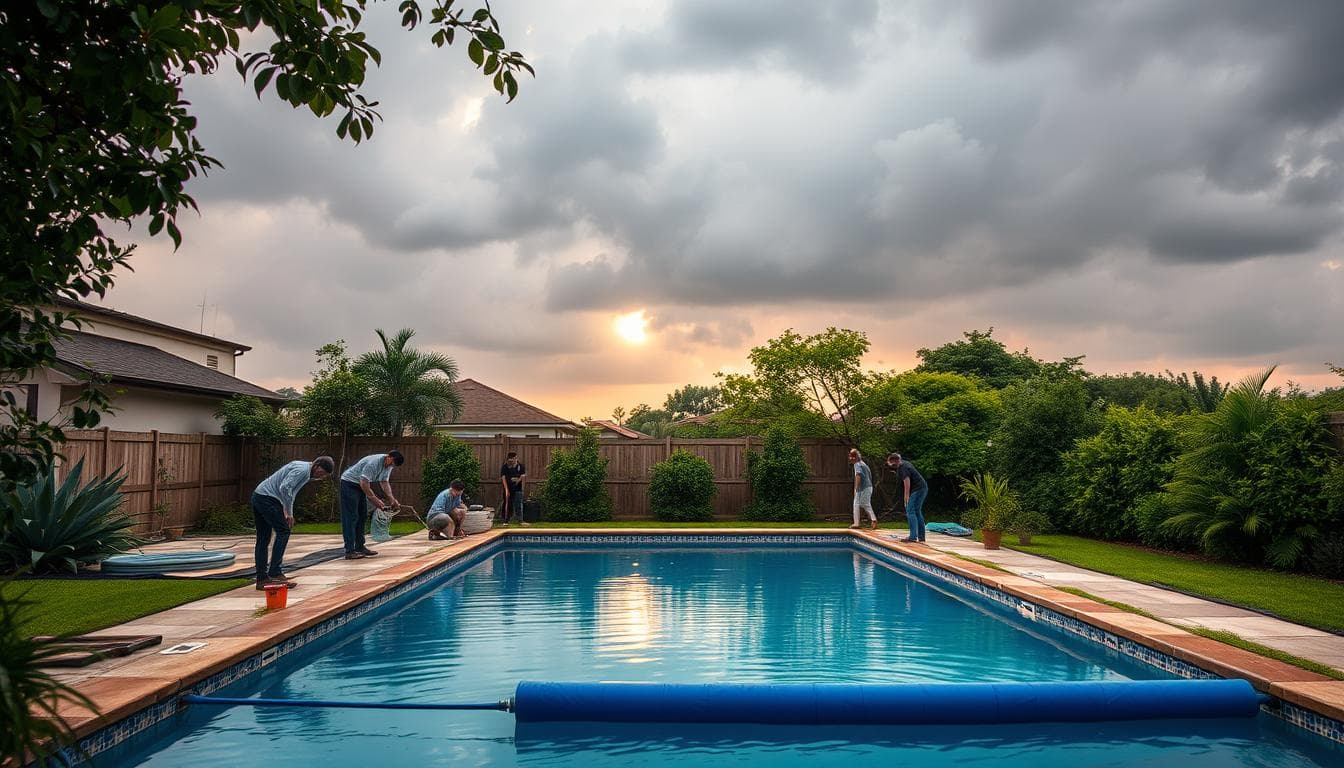How to Protect Your Pool During Arizona’s Monsoon Season
Protect your Arizona pool during the monsoon season with these essential maintenance tips. Keep water clear and equipment safe from storms and debris.

When summer arrives in the Southwest, the skies often shift from sunny to stormy in minutes. Between June 15th and September 30th, intense weather patterns bring heavy rain, strong winds, and swirling dust. For pool owners, this period demands extra attention to keep water clean and equipment safe.
Sudden downpours can flood your backyard oasis, while gusts scatter debris and dirt. These conditions strain filtration systems and alter chemical balances. Without quick action, you might face murky water, clogged drains, or even costly repairs. Staying ahead of the weather is key to avoiding headaches later.
At Litchfield Park Pool Service, we understand how unpredictable these months can be. Our team at 623-935-5121 specializes in helping homeowners prepare for storms. Simple steps like adjusting water levels or securing patio furniture make a big difference. With the right plan, you’ll spend less time worrying and more time enjoying your pool.
Key Takeaways
Monsoon weather in Arizona typically runs from mid-June through September
Heavy rain and wind can damage equipment and affect water quality
Proactive maintenance prevents most storm-related issues
Professional services simplify seasonal preparation
Quick adjustments during storms protect long-term pool health
Understanding Arizona’s Monsoon Season and Its Impact on Pools
Monsoon season in Arizona isn’t just about rain—it’s a cocktail of elements threatening pool health. Between mid-June and September, sudden downpours mix with dust clouds and 40+ mph winds. These conditions create unique hurdles for maintaining water clarity and equipment efficiency.

Weather Patterns That Test Pool Resilience
Torrential rains can drop 2-3 inches in under an hour, quickly raising water levels. This overflow dilutes chemicals and strains drainage systems. Meanwhile, dust storms reduce visibility to near-zero levels, coating surfaces with fine particles.
“Dust storms can overwhelm filters in minutes. Regular checks are crucial during peak monsoon weeks.”
Litchfield Park Pool Service
Pre-Monsoon Preparations for a Pristine Pool
Smart preparation transforms storm readiness from stressful to manageable. Start by clearing the area around your swimming space to minimize wind-blown hazards. A tidy environment helps equipment function properly and reduces post-storm cleanup.

Storing Pool Accessories and Protecting Outdoor Furniture
Store floats and toys in sealed containers or garages. Avoid using protective covers during active weather—they trap debris and strain anchoring systems. Wicker or plastic chairs should be stacked and tied down.
Clean filters before predicted storms to handle extra particles
Schedule professional maintenance checks in early June
Use waterproof bins for chemical storage
Proactive steps save time and money. When winds pick up, you’ll appreciate having taken these simple precautions. For personalized advice, reach out to local experts familiar with regional weather patterns.
Protect Your Pool During Arizona’s Monsoon Season with Preventative Measures
Not all protective measures deliver equal results when prepping for seasonal weather shifts. Choosing the right approach helps maintain water quality while safeguarding vital components.

Why Some Protective Covers Backfire
Solid vinyl covers often trap leaves and standing water during heavy rains. This creates breeding grounds for mosquitoes and adds dangerous weight to anchoring systems. Mesh alternatives allow better drainage but still require frequent debris removal.
Avoid automatic covers that can jam under wind pressure
Remove covers entirely if storms are predicted within 24 hours
Opt for safety covers with secure fasteners when needed
Landscaping for Lasting Protection
Overgrown trees near water features pose multiple risks. Trim branches at least 6 feet from the pool’s edge using proper pruning techniques:
“Cut at the branch collar angle to promote healing. Never leave stubs that attract pests.”
Clearing surrounding areas prevents three common issues:
Reduced organic matter entering the water
Lower risk of equipment damage from falling limbs
Improved sunlight exposure to discourage algae growth
Complete these tasks by early June for best results. Pair physical prep with weekly chemical checks to maintain balance through turbulent weather patterns.
Maintaining Pool Equipment and Water Chemistry During Storms
As storm clouds gather, pool owners face the dual challenge of preserving water quality and equipment integrity. Heavy rainfall dilutes sanitizers while wind-driven debris taxes filtration systems. Staying ahead requires both mechanical adjustments and chemical fine-tuning.

Optimizing Your Filtration System for Monsoon Conditions
Extended pump runtimes become essential during active weather. Increase daily operation by 2-3 hours to handle extra dirt and organic matter. Clean skimmer baskets every 4-6 hours when storms hit—clogged filters strain motors and reduce efficiency.
“Set timers to run pumps overnight after heavy rains. This clears suspended particles before they settle.”
Litchfield Park Pool Service
Follow this three-step process during debris influx:
Backwash sand filters when pressure gauges rise 8-10 PSI above normal
Hose cartridge filters with a 45-degree spray pattern
Inspect pump strainers for twigs or pebbles daily
Conclusion
Smart preparation and timely care keep your swimming area resilient through stormy months. Regular debris removal, chemical balancing, and equipment checks prevent algae growth while minimizing wind-related damage. Addressing water levels quickly avoids overflow issues, ensuring systems work efficiently.
Proactive measures like securing outdoor items and trimming trees pay off when gusts arrive. Post-storm restoration becomes simpler with consistent skimming and filter maintenance. These steps maintain water clarity, letting families enjoy worry-free dips even after heavy rains.
Need expert guidance? Our team at Litchfield Park Pool Service handles seasonal challenges daily. We optimize chemical levels, repair storm damage, and create customized care plans. Dial 623-935-5121 for swift solutions that keep your space inviting.
With thoughtful upkeep, your backyard retreat remains a refreshing oasis year after year. Here’s to many sunny days ahead—and storm-ready confidence when clouds gather!